You are using an out of date browser. It may not display this or other websites correctly.
You should upgrade or use an alternative browser.
You should upgrade or use an alternative browser.
Aircraft Carriers III
- Thread starter Jeff Head
- Start date
They should completely dismantle and replace all of their submarine building infrastructure with more for carrier building. Commit to 100 carriers by 2050. Big slow targets for our favorite hypersonic glide vehicles to bone into the bottom of the ocean. One shot one kill I hope?The United States Navy is building THREE nuclear powered Ford class carriers at Ingalls Shipbuilding in Newport News VA.
Newport News Shipbuilding Aircraft Carrier Update: March 2023
Intrepid
Major
They should negotiate more, build trust, renounce unfulfilled territorial claims, and end the arms race. There are so many important tasks that people have to solve peacefully together, that's where all the creativity should go.They should completely dismantle and replace all of their submarine building infrastructure with more for carrier building. Commit to 100 carriers by 2050. Big slow targets for our favorite hypersonic glide vehicles to bone into the bottom of the ocean. One shot one kill I hope?
Yea, but it's the US, so all of that are unrealistic ideas/proposals lol.They should negotiate more, build trust, renounce unfulfilled territorial claims, and end the arms race. There are so many important tasks that people have to solve peacefully together, that's where all the creativity should go.
I found an image of HMS Queen Elizabeth I while checking reddit for new clips from Ukraine. I'll post it below but first let me explain why I found it interesting. In the comments someone posted a link to youtube clip with "rolling landing" is a type of vertical landing with the aircraft coming town at an angle which allows air resistance to decrease velocity. Because despite (or perhaps because of) being a navy anthusiast I completely lost any interest in the dumpster fire that is the Royal Navy I wasn't aware that it existed.
Royal Navy practices it because it allows more flexibility with mass of the landing plane. Vertical landing is a difficult maneuver that requires the aircraft to be as light as possible for optimal conditions which means no payload and minimum fuel which is problematic if you're dropping vertically. Rolling landing is easier.
It is however only practiced by the Royal Navy because it completely defeats the purpose of having a VTOL aircraft which is to save space on deck. Because the aircraft comes at an angle it can't be placed at a more convenient spot near the edges of the deck because any error will put the aircraft in water. Therefore the area for "rolling landing" is as seen on the image right in the middle of the deck. That requires exactly the same amount of free space on approach as a barrier landing.
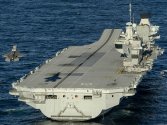
And this brings me to the image that inspired this post (in reduced resolution) showing deck in top view with 17 F-35Bs. Note their arrangement.
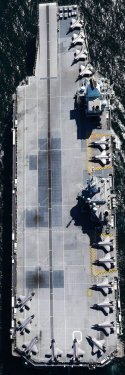
You can see very clearly the dark surface for designated vertical landing zone with darker spots from exhausts. The longer dark area is designated for "rolling landing".
You can also see how the aircraft on deck are distributed.
Compare with this.
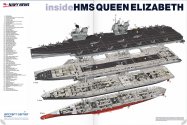
And this:
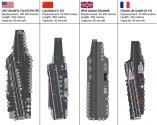
Spot the error on the images above.
Something I often bring up about online "experts" is the extent to which their online activity consists of engaging in delusional fantasies instead of advancing factual knowledge. This image here is a great example of it. It shows 42 aircraft on Ford's deck and 28 aircraft on QE, 15 aircraft on De Gaulle and only 9 on Liaoning.
This is how helos operate from QE - space is defined by lift requirements:
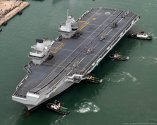
Note that this makes helo operations mutually exclusive with F-35B operations unless the helo is operating from the spot at the stern behind the lift. All the F-35B landing spots are where the helos are. The "rolling landing" guarantees a crash. And all that space between the runway and the islands? Wasted because you can't even park anything there because it's too close to the runway.
But what it all demonstrates is the sheer ridiculousness of QE design concept.
QE is a 65 000t carrier with a deck comparable in size to that of Ford, a 100 000t carrier: 284x73m vs 330x78m. This deck area is completely wasted by bad design choices. It is a clusterf... in a very literal sense once you imagine how F-35B and helos are supposed to operate at high tempo. Which indicates that it's not a high-tempo vessel. Then we have to remember that it only carries a maximum of 40 aircraft total of which allegedly 36 can be F-35Bs but how they would be utilized on such badly designed deck is beyond me.
Just adding an angled deck without a barrier or catapults would make it more viable. I can imagine what kinds of design constraints were put in place for this to be the final outcome. I would love to see the analyses that determined this design. I think I understand the logic but I'm not convinced that the logic worked out. I think it didn't but was forced through politically.
These two ships cost 7,9 billion GBP in 2019 which at then-current rate of 1,3USD per 1GBP was 10,3 billion USD. Considering that Royal Navy and Royal Fleet Auxiliary operate 6 large-deck amphibious vessels it would make more sense to invest in a smaller but more capable aircraft carrier not... whatever this is.
And to think that Brits often mock Russia for Kuznetsov's problems which stem from lack of proper support when the pride of their navy was deliberately designed like this. This entire ship was designed so it can operate between 12 to 16 F-35Bs as a maximum at any given time. 5 billion USD not counting aircraft and ships of escort to be able to put 16 F-35Bs in the air.
Royal Navy practices it because it allows more flexibility with mass of the landing plane. Vertical landing is a difficult maneuver that requires the aircraft to be as light as possible for optimal conditions which means no payload and minimum fuel which is problematic if you're dropping vertically. Rolling landing is easier.
It is however only practiced by the Royal Navy because it completely defeats the purpose of having a VTOL aircraft which is to save space on deck. Because the aircraft comes at an angle it can't be placed at a more convenient spot near the edges of the deck because any error will put the aircraft in water. Therefore the area for "rolling landing" is as seen on the image right in the middle of the deck. That requires exactly the same amount of free space on approach as a barrier landing.

And this brings me to the image that inspired this post (in reduced resolution) showing deck in top view with 17 F-35Bs. Note their arrangement.

You can see very clearly the dark surface for designated vertical landing zone with darker spots from exhausts. The longer dark area is designated for "rolling landing".
You can also see how the aircraft on deck are distributed.
Compare with this.

And this:

Spot the error on the images above.
Something I often bring up about online "experts" is the extent to which their online activity consists of engaging in delusional fantasies instead of advancing factual knowledge. This image here is a great example of it. It shows 42 aircraft on Ford's deck and 28 aircraft on QE, 15 aircraft on De Gaulle and only 9 on Liaoning.
This is how helos operate from QE - space is defined by lift requirements:

Note that this makes helo operations mutually exclusive with F-35B operations unless the helo is operating from the spot at the stern behind the lift. All the F-35B landing spots are where the helos are. The "rolling landing" guarantees a crash. And all that space between the runway and the islands? Wasted because you can't even park anything there because it's too close to the runway.
But what it all demonstrates is the sheer ridiculousness of QE design concept.
QE is a 65 000t carrier with a deck comparable in size to that of Ford, a 100 000t carrier: 284x73m vs 330x78m. This deck area is completely wasted by bad design choices. It is a clusterf... in a very literal sense once you imagine how F-35B and helos are supposed to operate at high tempo. Which indicates that it's not a high-tempo vessel. Then we have to remember that it only carries a maximum of 40 aircraft total of which allegedly 36 can be F-35Bs but how they would be utilized on such badly designed deck is beyond me.
Just adding an angled deck without a barrier or catapults would make it more viable. I can imagine what kinds of design constraints were put in place for this to be the final outcome. I would love to see the analyses that determined this design. I think I understand the logic but I'm not convinced that the logic worked out. I think it didn't but was forced through politically.
These two ships cost 7,9 billion GBP in 2019 which at then-current rate of 1,3USD per 1GBP was 10,3 billion USD. Considering that Royal Navy and Royal Fleet Auxiliary operate 6 large-deck amphibious vessels it would make more sense to invest in a smaller but more capable aircraft carrier not... whatever this is.
And to think that Brits often mock Russia for Kuznetsov's problems which stem from lack of proper support when the pride of their navy was deliberately designed like this. This entire ship was designed so it can operate between 12 to 16 F-35Bs as a maximum at any given time. 5 billion USD not counting aircraft and ships of escort to be able to put 16 F-35Bs in the air.
I can only assume that they could not be bothered with a complete re-design to make CVF a much better STVOL carrier. USN explored some designs during the CVX concept phase and they look nothing like what QE is.I found an image of HMS Queen Elizabeth I while checking reddit for new clips from Ukraine. I'll post it below but first let me explain why I found it interesting. In the comments someone posted a link to youtube clip with "rolling landing" is a type of vertical landing with the aircraft coming town at an angle which allows air resistance to decrease velocity. Because despite (or perhaps because of) being a navy anthusiast I completely lost any interest in the dumpster fire that is the Royal Navy I wasn't aware that it existed.
Royal Navy practices it because it allows more flexibility with mass of the landing plane. Vertical landing is a difficult maneuver that requires the aircraft to be as light as possible for optimal conditions which means no payload and minimum fuel which is problematic if you're dropping vertically. Rolling landing is easier.
It is however only practiced by the Royal Navy because it completely defeats the purpose of having a VTOL aircraft which is to save space on deck. Because the aircraft comes at an angle it can't be placed at a more convenient spot near the edges of the deck because any error will put the aircraft in water. Therefore the area for "rolling landing" is as seen on the image right in the middle of the deck. That requires exactly the same amount of free space on approach as a barrier landing.
View attachment 109862
And this brings me to the image that inspired this post (in reduced resolution) showing deck in top view with 17 F-35Bs. Note their arrangement.
View attachment 109866
You can see very clearly the dark surface for designated vertical landing zone with darker spots from exhausts. The longer dark area is designated for "rolling landing".
You can also see how the aircraft on deck are distributed.
Compare with this.
View attachment 109867
And this:
View attachment 109868
Spot the error on the images above.
Something I often bring up about online "experts" is the extent to which their online activity consists of engaging in delusional fantasies instead of advancing factual knowledge. This image here is a great example of it. It shows 42 aircraft on Ford's deck and 28 aircraft on QE, 15 aircraft on De Gaulle and only 9 on Liaoning.
This is how helos operate from QE - space is defined by lift requirements:
View attachment 109869
Note that this makes helo operations mutually exclusive with F-35B operations unless the helo is operating from the spot at the stern behind the lift. All the F-35B landing spots are where the helos are. The "rolling landing" guarantees a crash. And all that space between the runway and the islands? Wasted because you can't even park anything there because it's too close to the runway.
But what it all demonstrates is the sheer ridiculousness of QE design concept.
QE is a 65 000t carrier with a deck comparable in size to that of Ford, a 100 000t carrier: 284x73m vs 330x78m. This deck area is completely wasted by bad design choices. It is a clusterf... in a very literal sense once you imagine how F-35B and helos are supposed to operate at high tempo. Which indicates that it's not a high-tempo vessel. Then we have to remember that it only carries a maximum of 40 aircraft total of which allegedly 36 can be F-35Bs but how they would be utilized on such badly designed deck is beyond me.
Just adding an angled deck without a barrier or catapults would make it more viable. I can imagine what kinds of design constraints were put in place for this to be the final outcome. I would love to see the analyses that determined this design. I think I understand the logic but I'm not convinced that the logic worked out. I think it didn't but was forced through politically.
These two ships cost 7,9 billion GBP in 2019 which at then-current rate of 1,3USD per 1GBP was 10,3 billion USD. Considering that Royal Navy and Royal Fleet Auxiliary operate 6 large-deck amphibious vessels it would make more sense to invest in a smaller but more capable aircraft carrier not... whatever this is.
And to think that Brits often mock Russia for Kuznetsov's problems which stem from lack of proper support when the pride of their navy was deliberately designed like this. This entire ship was designed so it can operate between 12 to 16 F-35Bs as a maximum at any given time. 5 billion USD not counting aircraft and ships of escort to be able to put 16 F-35Bs in the air.
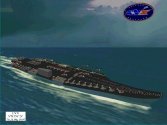
I found an image of HMS Queen Elizabeth I while checking reddit for new clips from Ukraine. I'll post it below but first let me explain why I found it interesting. In the comments someone posted a link to youtube clip with "rolling landing" is a type of vertical landing with the aircraft coming town at an angle which allows air resistance to decrease velocity. Because despite (or perhaps because of) being a navy anthusiast I completely lost any interest in the dumpster fire that is the Royal Navy I wasn't aware that it existed.
Royal Navy practices it because it allows more flexibility with mass of the landing plane. Vertical landing is a difficult maneuver that requires the aircraft to be as light as possible for optimal conditions which means no payload and minimum fuel which is problematic if you're dropping vertically. Rolling landing is easier.
It is however only practiced by the Royal Navy because it completely defeats the purpose of having a VTOL aircraft which is to save space on deck. Because the aircraft comes at an angle it can't be placed at a more convenient spot near the edges of the deck because any error will put the aircraft in water. Therefore the area for "rolling landing" is as seen on the image right in the middle of the deck. That requires exactly the same amount of free space on approach as a barrier landing.
View attachment 109862
And this brings me to the image that inspired this post (in reduced resolution) showing deck in top view with 17 F-35Bs. Note their arrangement.
View attachment 109866
You can see very clearly the dark surface for designated vertical landing zone with darker spots from exhausts. The longer dark area is designated for "rolling landing".
You can also see how the aircraft on deck are distributed.
Compare with this.
View attachment 109867
And this:
View attachment 109868
Spot the error on the images above.
Something I often bring up about online "experts" is the extent to which their online activity consists of engaging in delusional fantasies instead of advancing factual knowledge. This image here is a great example of it. It shows 42 aircraft on Ford's deck and 28 aircraft on QE, 15 aircraft on De Gaulle and only 9 on Liaoning.
This is how helos operate from QE - space is defined by lift requirements:
View attachment 109869
Note that this makes helo operations mutually exclusive with F-35B operations unless the helo is operating from the spot at the stern behind the lift. All the F-35B landing spots are where the helos are. The "rolling landing" guarantees a crash. And all that space between the runway and the islands? Wasted because you can't even park anything there because it's too close to the runway.
But what it all demonstrates is the sheer ridiculousness of QE design concept.
QE is a 65 000t carrier with a deck comparable in size to that of Ford, a 100 000t carrier: 284x73m vs 330x78m. This deck area is completely wasted by bad design choices. It is a clusterf... in a very literal sense once you imagine how F-35B and helos are supposed to operate at high tempo. Which indicates that it's not a high-tempo vessel. Then we have to remember that it only carries a maximum of 40 aircraft total of which allegedly 36 can be F-35Bs but how they would be utilized on such badly designed deck is beyond me.
Just adding an angled deck without a barrier or catapults would make it more viable. I can imagine what kinds of design constraints were put in place for this to be the final outcome. I would love to see the analyses that determined this design. I think I understand the logic but I'm not convinced that the logic worked out. I think it didn't but was forced through politically.
These two ships cost 7,9 billion GBP in 2019 which at then-current rate of 1,3USD per 1GBP was 10,3 billion USD. Considering that Royal Navy and Royal Fleet Auxiliary operate 6 large-deck amphibious vessels it would make more sense to invest in a smaller but more capable aircraft carrier not... whatever this is.
And to think that Brits often mock Russia for Kuznetsov's problems which stem from lack of proper support when the pride of their navy was deliberately designed like this. This entire ship was designed so it can operate between 12 to 16 F-35Bs as a maximum at any given time. 5 billion USD not counting aircraft and ships of escort to be able to put 16 F-35Bs in the air.
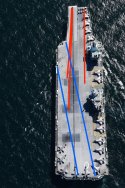
Might have benefited from a similar design like that of India's IAC-1. Instead of just adding an extra bit and wasting all that deck space.
I found an image of HMS Queen Elizabeth I while checking reddit for new clips from Ukraine. I'll post it below but first let me explain why I found it interesting. In the comments someone posted a link to youtube clip with "rolling landing" is a type of vertical landing with the aircraft coming town at an angle which allows air resistance to decrease velocity. Because despite (or perhaps because of) being a navy anthusiast I completely lost any interest in the dumpster fire that is the Royal Navy I wasn't aware that it existed.
Royal Navy practices it because it allows more flexibility with mass of the landing plane. Vertical landing is a difficult maneuver that requires the aircraft to be as light as possible for optimal conditions which means no payload and minimum fuel which is problematic if you're dropping vertically. Rolling landing is easier.
It is however only practiced by the Royal Navy because it completely defeats the purpose of having a VTOL aircraft which is to save space on deck. Because the aircraft comes at an angle it can't be placed at a more convenient spot near the edges of the deck because any error will put the aircraft in water. Therefore the area for "rolling landing" is as seen on the image right in the middle of the deck. That requires exactly the same amount of free space on approach as a barrier landing.
View attachment 109862
And this brings me to the image that inspired this post (in reduced resolution) showing deck in top view with 17 F-35Bs. Note their arrangement.
View attachment 109866
You can see very clearly the dark surface for designated vertical landing zone with darker spots from exhausts. The longer dark area is designated for "rolling landing".
You can also see how the aircraft on deck are distributed.
Compare with this.
View attachment 109867
And this:
View attachment 109868
Spot the error on the images above.
Something I often bring up about online "experts" is the extent to which their online activity consists of engaging in delusional fantasies instead of advancing factual knowledge. This image here is a great example of it. It shows 42 aircraft on Ford's deck and 28 aircraft on QE, 15 aircraft on De Gaulle and only 9 on Liaoning.
This is how helos operate from QE - space is defined by lift requirements:
View attachment 109869
Note that this makes helo operations mutually exclusive with F-35B operations unless the helo is operating from the spot at the stern behind the lift. All the F-35B landing spots are where the helos are. The "rolling landing" guarantees a crash. And all that space between the runway and the islands? Wasted because you can't even park anything there because it's too close to the runway.
But what it all demonstrates is the sheer ridiculousness of QE design concept.
QE is a 65 000t carrier with a deck comparable in size to that of Ford, a 100 000t carrier: 284x73m vs 330x78m. This deck area is completely wasted by bad design choices. It is a clusterf... in a very literal sense once you imagine how F-35B and helos are supposed to operate at high tempo. Which indicates that it's not a high-tempo vessel. Then we have to remember that it only carries a maximum of 40 aircraft total of which allegedly 36 can be F-35Bs but how they would be utilized on such badly designed deck is beyond me.
Just adding an angled deck without a barrier or catapults would make it more viable. I can imagine what kinds of design constraints were put in place for this to be the final outcome. I would love to see the analyses that determined this design. I think I understand the logic but I'm not convinced that the logic worked out. I think it didn't but was forced through politically.
These two ships cost 7,9 billion GBP in 2019 which at then-current rate of 1,3USD per 1GBP was 10,3 billion USD. Considering that Royal Navy and Royal Fleet Auxiliary operate 6 large-deck amphibious vessels it would make more sense to invest in a smaller but more capable aircraft carrier not... whatever this is.
And to think that Brits often mock Russia for Kuznetsov's problems which stem from lack of proper support when the pride of their navy was deliberately designed like this. This entire ship was designed so it can operate between 12 to 16 F-35Bs as a maximum at any given time. 5 billion USD not counting aircraft and ships of escort to be able to put 16 F-35Bs in the air.
Isn't the QE2 supposedly fitted-for-but-not-with catapults? Which kinda explains this neither here nor there frankendesign.
(Not that I agree with the design or cost-for-capability)
The QE class design was intended to be able to be built with either catapults or not because the design was supposed to be shared with the French. The French wanted the catapults. The UK was supposed to operate the F-35B so they did not want the catapults. From what I understand once they started cutting metal on HMS Queen Elizabeth it became impossible to retrofit the catapults into it. There was talk about building the later HMS Prince of Wales with catapults so they could buy the much more effective F-35C but they had to give up on that as well.
